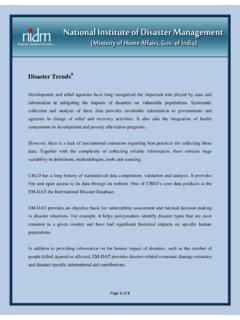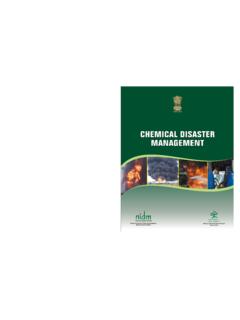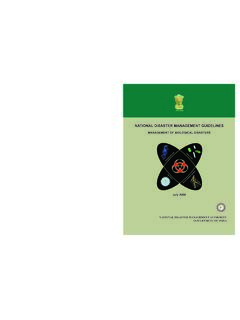Transcription of CONDITION ASSESSMENT OF BUILDINGS
1 CONDITION ASSESSMENT OF BUILDINGS . FOR. REPAIR AND UPGRADING. Prepared under:- GoI-UNDP Disaster, Risk Management Programme National Disaster Management Division Ministry of Home Affairs, Government of India New Delhi June 2007. Contents 1. Objective of the Guide 2. Factors causing building distress 3. Rehabilitation and Seismic Retrofitting of BUILDINGS 4. CONDITION ASSESSMENT of BUILDINGS main objective of CONDITION ASSESSMENT Main steps of CONDITION ASSESSMENT Typical visible detrimental to the safety of BUILDINGS Main causes of such distress in BUILDINGS 5. Methodology of CONDITION ASSESSMENT Rapid (visual) investigation Information needed for rapid investigation Details in visual investigation Observation of settlement or differential settlement of BUILDINGS 6.
2 Detailed Investigations Need and actions Tests for ASSESSMENT of in-situ quality of reinforced concrete Test of concrete strength Rebound hammer test Ultrasonic pulse velocity (UPV) technique Core tests 7. Partially Destructive tests Penetration resistance Pull-out testing Pull-off method Interpretation about corrosion based on chemical analysis of concrete Location od steel reinforcement in RC structures by non-destructive tests Samples of steel reinforcement for determining the strength and other properties Corrosion of reinforcement in RC structures. 8. Soil Profiles at the Site 9. Concluding Remarks 10. Acknowledgement 11. References 2. CONDITION ASSESSMENT OF BUILDINGS FOR. REPAIR AND SEISMIC UPGRADING.
3 1 Objective of this guide The main purpose of guide is to briefly describe how to carry out the CONDITION ASSESSMENT of BUILDINGS before taking up repair and upgrading work. This will determine whether or not a distressed building should be demolished to build back better or whether it will be cost-effective to either repair or retrofit it, in the context of overall safety. 2 Factors causing building Distress? (i) The reason for distress during service is the lack of maintenance of the building which results in deterioration/aging of materials and structural components leading to corrosion and cracking. (ii) BUILDINGS or structures are damaged at different grades of damage when they experience extreme loading conditions like in severe earthquakes or cyclonic storms for which they are not designed.
4 (iii) They may also fail if the building including the foundation is not properly designed and constructed following the standard Codes of practice. An impression exists that taller structures are seismically unsafe in comparison with low-rise BUILDINGS . On the contrary, when properly designed and built, taller structures are generally safer. It is to be noted that most lives were lost in Kachchh (Gujarat). earthquake of 2001 in one and two storeyed masonry BUILDINGS . Hence, all BUILDINGS have to be built safe. (iv) Inadequacy of design and poor quality of construction and maintenance are therefore the main reasons for the distress seen in BUILDINGS during service or under natural hazards. This is because building codes and byelaws are not conscientiously followed in design and quality of construction, nor in maintenance.
5 (v) The current [Indian standard ( )] building codes and guidelines in India have been tested and found effective in achieving safety of the residents during the last six earthquakes (Uttarkashi 1991 to J & K 2005). Hence not following these codes in design and construction is sure recipe for distress in future. 3 Rehabilitation and Seismic Retrofitting of BUILDINGS Rehabilitation denotes repairing BUILDINGS damaged during service or by earthquakes without upgrading the seismic resistance, while seismic retrofitting denotes upgrading the safety of damaged or existing deficient BUILDINGS . The effects of these operations on the structural strength and deformation capacity may be seen in the figure 1: :- Effects of seismic retrofitting and routine repair or rehabilitation 3.
6 4 CONDITION ASSESSMENT of BUILDINGS Main objective of CONDITION ASSESSMENT are to place the building into one of the following three categories: A The building has not shown any signs of distress and It satisfies all the safety and serviceability requirements according to relevant Codes of practice, hence no action is needed towards retrofitting. B The building is seen to be deficient (or distressed) but it can be repaired and strengthened to satisfy the Codal safety requirements or performance criteria set by the user. C The building is badly damaged. It is to be demolished and a new building may be built, build back better. Main steps of CONDITION ASSESSMENT will be a) To record the damage if any, and find out the causes for distress b) To assess the extent of distress and to estimate the residual strengths of structural components and the system including the foundation.
7 C) To plan the rehabilitation and retrofitting/strengthening of the building . Typical visible distress detrimental to the safety of BUILDINGS Cracks in RC beams ( ), Columns (Fig 3), slabs, masonry walls (particularly if the walls are load bearing walls) (Fig. 4, 5), spalling of concrete, sagging of beams or slabs ( ), and tilting of c o l u m n s or RC frames (out of plumb) (Figs. 7) and major failure of structural members (8-11) are the typical types of crucial damages that will require structural repairs to bring back the lost strength. Such actions will need to be done along with retrofitting if that is also decided for the building in question. :- Diagonal cracks of the beam and failure at the column top :- Cracks in column 4.
8 4.. :- Cracks in masonry wall :- Cracks in good quality brick wall :- Failure of a portion of :- Failure in column-beam joint (lack of stirrups). building (at expansion joint). :- Column failure (absence :- Column top failure (bad joint detail). of tiers, buckling of longitudinal bars). 5. :- Corrosion in RC beam :- Corrosion in the RC Column :- Corrosion in the RC slab (lack of control on the cover). Main causes of such distress in BUILDINGS Either one or more of the factors listed below may cause distress in BUILDINGS ( ): Deficiencies in design Poor detailing of reinforcement in RC structural members and joints Poor quality of construction Corrosion of reinforcement due to aggressive environment.
9 Inadequacies in the structural system to resist lateral forces due to natural hazards like cyclones and earthquakes. Settlement or differential settlement of foundation Extreme and unforeseen loading. 6. 5 Methodology of CONDITION ASSESSMENT CONDITION ASSESSMENT and evaluation is generally carried out in two levels: (i) Preliminary and (ii) detailed. If we get adequate information to assess the safety of the building at the preliminary investigation level, detailed investigation, which involves considerable cost and time, may not be recommended. Rapid (Visual) Investigation There are mainly three components and steps: Collection of information and details about the building design, construction, utilization, and maintenance in the past Visual inspection of CONDITION at site and recording details of distress Evaluation of safety against the provisions in building codes or specified performance criteria Information needed for Rapid investigation One needs a complete record of building design details and drawings, architectural details, construction details and drawings including the specifications of materials used, geotechnical details of the area and foundation particulars, details of any repair or retrofitting done from the time of construction, details of usage of the building including the loads.
10 Some nondestructive testing may be required to check the strength of concrete masonry etc. If the above information is not available, detailed investigations have to be conducted. Details in visual Investigation The main purpose of visual investigation is to observe and note down all the items of distress or design deficiency and their locations, supported by sketches and drawings. The visual inspection includes: Verification of the accuracy of the original drawings or determination of basic building information, if no drawings are available. Identification of major alterations not shown on the original construction documents. 1dentification of visible structural damage, such as concrete cracking or spa1ling, and observations on quality of construction Identification of potential non-structural falling hazards, including ceilings, partitions, curtain Walls, parapets, fixtures, and other non-structural building elements.







